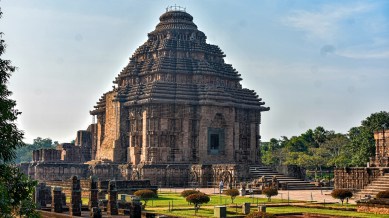📣 For more lifestyle news, click here to join our WhatsApp Channel and also follow us on Instagram
These 5 monuments in India are over 500-years-old
Each of these monuments offers a glimpse into a bygone era

India’s architectural heritage is truly remarkable. From ancient temples to grand palaces, the country is home to numerous impressive structures from diverse cultures. Some of these buildings are over 500 years old and have withstood the test of time. Take a look at some of the most exemplary monuments, pleasing visitors with their iconic appearance even today:
Hampi, Karnataka
Hampi was once the capital of the Vijayanagara Empire and is now one of India’s most fascinating archaeological sites, recognized as a UNESCO World Heritage Site. Dating back to the early 14th century, Hampi’s ruins cover more than 4,000 hectares and include beautifully carved temples, palaces, and markets. Highlights such as the Virupaksha Temple, the Vittala Temple with its famous stone chariot, and the Lotus Mahal showcase Dravidian architecture at its finest. Even after centuries of change, Hampi offers a glimpse into South India’s rich history of art, trade, and spirituality.
Agra Fort, Uttar Pradesh
Agra Fort, built by Emperor Akbar in 1565 CE, is one of the most important monuments from the Mughal era. While it is over 450 years old, some parts are even older, dating back more than 500 years. The fort served as the main residence of the Mughal emperors until 1638. Made mostly of red sandstone, its huge walls surround beautiful palaces such as the Jahangiri Mahal, Diwan-i-Khas, and Musamman Burj, where Shah Jahan, who built the Taj Mahal, was held by his son, Aurangzeb. The fort’s mix of Hindu and Persian styles shows the cultural blend of the Mughal period.
Meenakshi Amman Temple, Tamil Nadu
The Meenakshi Amman Temple in Madurai is one of India’s most famous architectural wonders. While its history goes back more than 2,000 years, most of what we see today was rebuilt and expanded in the 16th century during the Nayak dynasty, over 500 years ago. The temple is dedicated to Goddess Meenakshi (a form of Parvati) and Lord Sundareswarar (Shiva). It is known for its tall gateway towers, called gopurams, which are adorned with thousands of colourful sculptures depicting gods, animals, and mythological stories. The temple’s wide corridors and sacred tank, Porthamarai Kulam, make it a vibrant centre of Dravidian art and worship.
Chittorgarh Fort, Rajasthan
Chittorgarh Fort in Rajasthan is a symbol of Rajput bravery and pride, and is one of India’s oldest and largest forts. Its foundation was laid in the 7th century, but many of its most famous buildings, like the Vijay Stambh (Tower of Victory), built in 1448 CE and the Kirti Stambh (Tower of Fame), are over 500 years old. Covering 700 acres, Chittorgarh is full of stories about courage, sacrifice, and strength. The fort faced several sieges, including attacks by Alauddin Khilji and Akbar, and still stands as a proud symbol of Rajputana’s spirit.
Konark Sun Temple, Odisha
The Konark Sun Temple, built in the 13th century (around 1250 CE) by King Narasimhadeva I of the Eastern Ganga dynasty, is a stunning example of Kalinga architecture. Designed to resemble a giant stone chariot for the Sun God, the temple once featured 24 carved wheels and seven stone horses, representing the Sun’s journey across the sky. Although some parts of the temple have been damaged over the years, its detailed carvings and precise design continue to impress historians and architects worldwide. As a UNESCO World Heritage Site, Konark shows India’s ancient skill in science and art.
📣 For more lifestyle news, click here to join our WhatsApp Channel and also follow us on Instagram